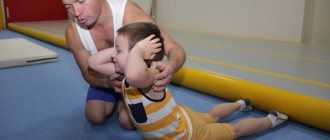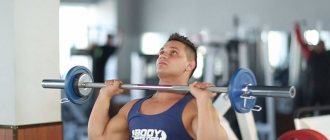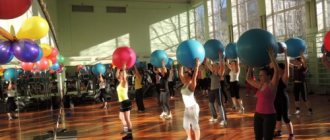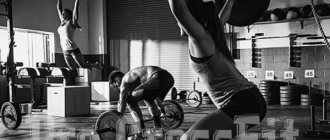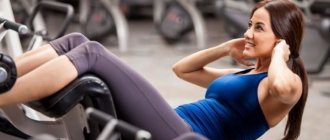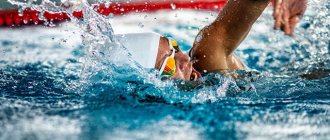The success of the workout depends not only on the correct technique of performing the exercises. We also need a competent program, where each movement helps in the development of a certain area of the body. If you want to get the most out of your classes, you will find a lot of interesting information in this article.
How to create a training program? There are different schools of thought as to what to look for and what exercises are best. But more about everything.
Features of the program
To clearly explain all the principles of a proper training program, you would have to write a whole book - there is so much useful information that a beginner athlete needs to learn (experienced athletes do not have problems with this). However, there is a standard minimum that should be considered when developing a suitable scheme.
Of course, it is much easier to ask a coach for help. Every beginner, when visiting the gym, is “equipped” with the first standard training program. Everything would be fine, but for everyone, approximately the same plan is drawn up, which does not take into account actual physical data. Only over time does a specialist establish the real state of affairs and make adjustments to the scheme.
What to do during home exercises, because there is no trainer nearby? In this case, the athlete has to independently study the information. In order to compose the program as competently as possible, be sure to take into account the following points.
Complex loads on all muscle groups
When developing a home exercise schedule, it's a good idea to start with a weekly plan. After the first few lessons, it will be clear in which direction to make changes and whether it is worth introducing something new.
For newbies
A comprehensive program for beginners should include a base, warm-up and final stretching. A four-day workout involves rest in the middle of the week (Wednesday) and the weekend (Saturday, Sunday).
The Beginner Plan includes:
- Warm up:
- rotation of joints (shoulders, elbows, hands, knees, feet);
- jumping rope – 2-3 minutes;
- burpees – 20-30 times.
- Power block.
- Final stretching (stretching as you exhale, lowering your body as you inhale).
The basis is a strength block (Monday, Thursday) and circuit training (Tuesday, Friday). Elements of the latter are performed for 20-30 seconds with a 10-second rest between circles.
| Monday | Tuesday (2 laps of 20 seconds) | Thursday | Friday (2 laps of 30 seconds) | |
| 1. | Push-ups – 3/8-10 | Burpee | Push-ups – 3/8-10 | Push ups |
| 2. | Bent-over dumbbell row – 3/8-10 | Rock climber | Standing dumbbell fly – 3/8-10 | Burpee |
| 3. | Lifting the body (press) – 3/10 | Jump Squat | Lunges – 3/10-12 | Squat |
| 4. | Dumbbell row up – 3/8-10 | Push ups | Leg raises for lower abs – 3/10 | Rock climber |
| 5. | Plank – 30 seconds | Plank | Plank – 30 seconds | Plank |
For experienced
Professionals train 2-3 times a week. Their lesson plan includes a base and some isolation elements. Strength stretching allows you to prepare your muscles for total loads, and cardio will improve the elasticity of the ligaments.
Approximate 1.5-hour program implemented at home:
Day I (arms, shoulders, chest, back)
Dumbbell rows from a lying position – 2-3/6-8.
- Dumbbell lateral raises – 2-3/6-8.
- Overhead press – 2-3/6-8.
- Projectile thrust in an inclined position – 2-3/6-8.
- Push-ups – 2-3/15-20.
Day II (legs, hips, back)
- Weighted squat – 3/12-12.
- Lunges with dumbbells – 3/10-12.
- Deadlift with apparatus – 3/10-12.
- Calf raises with dumbbells – 2/20.
- Sumo deadlift with one apparatus – 3/10-12.
Finally, you need to do muscle stretching for 2-3 minutes to restore breathing and blood circulation.
Deciding on goals
The first step in creating a program is defining your goals. In no case should you use floating formulations, for example, “I want to lose weight” or “I want to improve my shape.” It is important to set clear goals for yourself. This is not only excellent motivation, but also an opportunity to understand what you still need to pay attention to. Within a certain amount of time, you can set any adequate goals:
- Lose weight by 5 kilograms.
- Increase strength indicators by 10%.
- Fit into your favorite jeans that barely fasten.
Decide how many times a week we will train
There should be at least one fitness workout per week - this is already better than a complete absence of sports in life. The optimal number of classes is 3. If at first it is not possible to allocate more time for quality training, we start small, gradually adding new “hours”.
Interesting fact. There is no need to overdo it with the number of classes. This is especially true for beginners. Their body is not yet ready for serious stress. With the wrong approach, the effect of overtraining can occur, which significantly slows down progress and leads to injury.
Choosing days for training
Do not neglect this point. We try to arrange the training correctly. There must be a break between them - we maintain a balance between classes and periods of rest. Ideal to train on Monday, Wednesday and Friday.
But if you can only do this on Saturday and Sunday, we’ll leave it that way. Of course, this option is undesirable, but the athlete has a whole week to restore muscles after a full workout with warm-up and cool-down.
The benefits of training
Strength exercises help to lose excess weight, overcome depression, and diseases of the cardiovascular system . Regular training at home will increase self-confidence and stabilize your mood. Complex strength exercise triggers an energy transformation mechanism in the muscles, with the help of which they adapt to increasing load.
The fat layer decreases, muscle mass increases. The body copes better with physical activity at home and at work, and becomes more resilient. Bodybuilding is useful for developing the main masculine qualities: courage, willpower, constancy.
“The world has never been interested in weakness. He always stayed strong. That same inner strength that years of training with iron add to us. So the main difference between us and others is not bulging muscles, but another, incomparably high and strong spirit,” says Arnold Schwarzenegger.
Frederic Delavier, author of the book “Anatomy of Strength Exercises,” explains and illustrates the technology for performing each element of training from the point of view of human anatomy and physiology. The pictures show the colors of the muscles that bear the load, provide recommendations for implementation and warnings against muscle injuries.
For beginners, this bodybuilding encyclopedia is an indispensable tool for practicing at home . Frederic Delavier - French scientist, former weightlifting champion; anatomy and physiology of physical development are the subject of his scientific interest.
Selecting areas of the body to work on
This step helps to structure the workout and create the most effective scheme where all the necessary areas of the body will be involved. Upgrading all zones at once within one lesson is problematic and not advisable. Therefore, it is customary to divide muscles into the following groups:
- Back.
- Legs.
- Press.
- Hands.
- Breast.
- Shoulders.
We devote different amounts of time to each section. The frequency and frequency of working out each muscle group depend on the initial goals and objectives when drawing up the program.
Interesting fact. To lose weight and simply maintain health, it is enough to train each muscle group once a week. Over time, when there are more opportunities, we will increase the number of classes.
Complexes of physical exercises. methodological development on physical education on the topic
Complexes of physical exercises.
MOVEMENT EXERCISES
- Slow jog up to 3 minutes.
- Exercises to restore breathing.
- Hands up, inhale, hands down, exhale.
- Posture exercises:
- Arms to the sides - walking on toes.
- Hands on waist - walking on heels.
- Hands up with palms facing inward - walking on straight legs. (Do not bend your knees while walking)
- Hands behind your back - walking on the inner and outer arches of the foot.
- Hands clasped behind your head, elbows to the sides - walking in a semi-squat. (Keep your back straight).
- Hands on knees walking in a full squat.
- Walking with crabs. (Turn your back forward, sit down, hands with palms on the floor, legs bent at the knees).
EXERCISES IN A STANDING POSITION.
- I.P. legs apart (narrow stance), hands behind your back. Circular rotations of the head 1-8 to the left, 1-8 to the right.
- I.P. legs apart (narrow stance), hands behind your back. 1 - head tilt to the left, 2 - to the right, 3 - forward, 4 - backward.
- I.P. legs apart (narrow stance), fingers locked 1-8 rotational movements of the hands forward, 1-8 back, 1-8 wavy.
- I.P. Legs apart (middle stance), arms to the sides - elbow joint
relax, circular rotations with your forearms, 1-4 inward, 1-4 relax, 1-4 outward, 1-4 relax.
- I.P. Feet apart (middle stance), hands to shoulders. 1- 4 forward circular rotations, 1- 4 backward circular rotations.
- I.P. Legs apart (middle stance), hands on the waist (tilt the torso forward) 1-8 circular rotations with the torso to the right, 1-8 circular rotations with the torso to the left (bend as much as possible).
- I.P. Legs apart (middle stance), hands locked behind the head, 1-8 circular rotations in the hip joint to the right, 1-8 circular rotations in the hip joint to the left (bend as much as possible).
- I.P. Legs apart, feet parallel (middle stance), hands on knees. 1-4 when squatting, we bring our knees inward, 1-4 when squatting, we move our knees outward.
- I.P. Hands behind the back, right foot on the toe 1-8 rotate the ankle to the right, 1-8 rotate the ankle to the left. Also the left leg.
- I.P. Legs apart (middle stance), fingers locked with palms facing the chest. 1- arms forward with palms facing outward, 2- I.P. 3- arms up with palms facing outward, 4- I.P..
- I.P. Legs apart (middle stance), right hand at the top, left hand at the bottom, 1-4 jerks with the arms. We change the position of the hands.
- I.P. Legs apart (middle stance), arms in front of the chest, elbows bent, 1-4 jerks with bent arms, 1-4 jerks with straight arms.
- I.P. Feet apart (middle stance), arms to the sides, fingers relaxed. 1 - hands to shoulders, fingers clenched into fists, 2 - hands up, fingers relaxed, 3 - hands to shoulders, fingers clenched into fists, 4 - hands to the sides, fingers relaxed.
- I.P. Legs apart (middle stance), arms forward 1 - squeeze fingers with force, 2 - relax 3-4 too.
- I.P. Feet apart (narrow stance), arms forward, palms down. Scissors 1-8 small amplitude, 1-8 large amplitude.
- I.P. Feet apart (narrow stance), arms forward crossed with palms facing inward (palms facing each other), fingers interlocked. 1- rotational movements are performed from the bottom up (the hands move towards the body and straighten forward). 2-I.P. (rotational movement is performed in the opposite direction). 3-4 too.
- I.P. Legs apart (middle stance), feet parallel to the arms on the belt. 1-2 tilt to the left, 3-4 tilt to the right.
- I.P. Legs apart (middle stance), feet parallel, hands clasped behind the head. 1- turn left, 2- I.P., 3- turn right, 4- I.P..
- I.P. Legs apart (middle stance), feet parallel, hands on the belt. 1- 3 smooth bends forward (do not bend your knees, try to touch the floor with your hands), 4- bend back.
- I.P. The left leg is straight, the toe is on the heel, the right leg is bent at the knee, the left hand is behind the back. 1-4 springy bends towards the left straight leg, trying to touch the toes with the palm of the hand. We change the position of the legs. We also do the same for the other leg.
- I.P. Legs together, arms down in front, palms to feet. Without bending your knees, move your hands one by one down your legs, then on the floor forward until you lie down, do a push-up, and without bending your knees, move your hands one by one to rise into the IP position.
- I.P. Legs apart (wide stance), arms bent at the elbows (right palm to the left elbow, left palm to the right elbow). 1-3 springy and smooth bends forward, 4 - bend back (try to touch the floor with your elbows).
- I.P. Feet together, grab your calves with your hands and stretch your forehead to your knees, hold 1-8. Smoothly straighten up, bending back a little and relax.
- I.P. Legs apart (middle stance), feet parallel, hands with palms on the floor. “Bear” We take a few steps forward (right hand right leg, left hand left leg), stop the arms and legs in parallel (leaning on the hands, pushing off with both legs and lifting the legs up), “kick” walking backwards (the same way), stop and "bouncing".
- I.P. Legs apart (middle stance), feet parallel, grab the ankle with your hands and relax (rest).
- I.P. Feet apart (wide stance), arms to the sides, fingers clenched into fists. "Mill". Lean forward, 1- with your right hand to reach your left leg, 2- I.P. 3- with your left hand, reach your right leg 4-I.P.
- I.P. Legs apart, feet parallel (middle stance) – arms forward, palms down. Half squat, back straight. 1-3 spring squats, 4-IP.
- I.P. Feet together - arms forward, palms down. Half squat, back straight. 1-3 spring squats, 4-IP..
- I.P. Legs apart, feet parallel (wide stance) - arms forward, palms down. 1-3 spring squats, 4-IP..
- I.P. The right arm is bent at the elbow, the fingers are clenched into a fist (fist at shoulder level), the left leg is back on the toe. 1 - turn towards the hand, 2-I.P., 3- turn towards the hand, 4-I.P. We change the position of the arms and legs.
- I.P. Legs apart (middle stance), feet parallel, hands behind the back, fingers connected (right hand on top, elbow behind the head, left hand on the bottom, elbow behind the back).
- sit down (back straight)
- I.P..
- sit down (back straight)
4-I.P.
Change hand positions.
1-4 too.
- I.P..Hands behind your back, legs apart, feet parallel (narrow stance).
- movement of the pelvis to the left
- movement of the pelvis to the right
- forward movement of the pelvis
- backward movement of the pelvis.
Keep your back straight.
- I.P. Legs apart, feet parallel, hands clasped behind the head (narrow stance - half squat).
1-4 - circular movements of the pelvis to the left.
1-4 circular movements of the pelvis to the right.
Keep your back straight.
- I.P. Legs apart, feet parallel (middle stance)
1-8 - smooth inhalation (inhale to the maximum).
While inhaling, we stretch the spine and, while holding our breath, hold the stretched spine with our muscles for as long as possible.
1-8 exhale and relax.
- I.P. Legs apart, feet parallel (wide stance).
1-2 - spread your arms to the sides and take a smooth breath.
1-2 - hands swish the floor in arcs forward, turn your palms inward, at the same time rise on your toes, exhale smoothly and perform a half-squat while remaining on your toes. Hold your breath (as much as possible) and remain in this position.
1-4 smooth breaths, simultaneously lower your entire foot and straighten up to relax.
- I.P. right leg in front, left behind (wide stance), toes pointing forward, hands on the knee of the leg in front.
1-4 - springy swinging with lowering down until pain is felt.
- change the position of the legs.
- I.P. Legs apart (wide stance) feet parallel.
We transfer the body weight to the right leg, hands to the knees of the right leg
1-4 springy swings to the right side.
1-4 to the left.
- I.P. Full squat on the right leg, left leg straight to the side on the heel, arms forward.
- a roll is performed from the right leg to the left leg.
- 2-roll from the left leg to the right leg. 3-4 too.
Exercises in a sitting position.
- I.P. Sit your legs apart, 1-bend to the left leg, 2-bend to the right leg, 3-bend in the middle, 4-straighten up and, bending slightly back, relax.
- I.P. Sit your legs together, 1-3 - bend forward, 4 - straighten.
- I.P. In a sitting position, one leg is bent at the knee, the shin is turned outward, the ankle is turned forward, the second is straight, 1-4 bends to the straight leg, 1-4 to the bent leg. We change the position of the legs and perform bends.
- I.P. Sit on the floor, legs together, arms supported behind you. 1- bend your right leg at the knee, 2- straighten your leg up. 3- bend at the knee, 4- IP 1-4- left leg.
- I.P. Sit on the floor with your legs together, support your hands behind you. 1- pull your legs bent at the knees towards you, 2- straighten them up. 3- bend your knees and pull them towards you, 4- put them on the floor.
- Lie on your back with your legs apart and relax.
Exercises in a lying position.
- I.P. Lying on your back, raise your legs up, supporting your lower back with your hands. “Bicycle”. 1-10 perform forward movements with your legs. 1-10 perform backward movements with your legs.
- I.P. Lying on your back, raise your legs straight up. Supporting your lower back with your hands, spread 1 leg apart, 2 legs crossed - right leg in front, left leg behind. 3 legs spread apart. 4 cross – left leg in front, right leg behind. 5 – spread to the sides. 6-right forward, left back, 7-left forward, right back. 8-legs spread to the sides.
- I.P. Lying on your back, hands locked behind your head. 1- connect the right elbow and left knee, 2-I.P. 3- connect the left elbow and right knee, 4-I.P.
- I.P. Lie on your back with your legs apart and relax.
- I.P. lying on your back, hands clasped behind your head. 1-connect both elbows and both knees. 2-I.P., 3- connect both elbows and both knees 4- return to the starting position.
- I.P. Lying on your back, legs apart, arms along your body, relax.
- I.P. Lying on your back, legs together, arms along the body. 1- pull the right leg, bent at the knee, towards you, 2- turn to the left, 3- pull it towards you, 4- turn to the right, 5- pull it towards you, 6- put it down. 1-6 left leg.
- I.P. Lying on your back, 1-pull both legs bent at the knees towards you, 2-turn to the right, 3-turn to the left, 4-pull them towards you and place them on the floor.
- I.P. Lie on your back with your legs apart and relax.
- I.P. Lying on your back, hands behind your head. 1-raise your torso, trying to touch your forehead to your knees. 2- I.P. 3-4 too.
- I.P. Lying on your back, legs apart, arms along your body, relax.
- I.P. Lying on your back, legs apart, arms along the body. 1- tighten the muscles of the buttocks, 2- relax, 3- 4 the same.
- I.P. Lying on your back, arms along your body, legs together. 1- Raise your legs straight, trying to touch the floor behind your head. 2- lower smoothly. 3-4 too.
- I.P. Lying on your back, legs apart, arms along your body, relax.
- I.P. Lying on your back, arms along your body, legs together. 1- raise straight legs to touch the floor behind your head, 2- straighten up, 3- touch the floor behind your head, 4- straighten up (6-10 series are performed).
- I.P. Lying on your back, legs together, arms along the body, relax.
- I.P. Lying on your back, arms along your torso, legs together. 1- tighten the muscles of the buttocks, 2- relax, 3- tighten the chest muscles, 4- relax.
- I.P. lying on your back, arms along your body – raise your straight legs by 5 cm. from the floor and hold for up to 30 seconds. Repeat 3-4 times.
- I.P. Lying on your back, legs apart, arms along your body, relax.
- I.P. Lying on your right side, right leg bent at the knee, left leg straight.
- Swing your left leg up, 2- lower, 3- swing forward, 4- swing back. Perform 15-20 times.
- And P. Lying on the right side, raise both legs 5-7 cm. from the floor and hold for 10-15 seconds.
Perform 3-4 times.
- I.P. Lying on your back, legs apart, arms along your body, relax.
- I.P. Lying on your left side, left leg bent at the knee, right leg straight.
- swing your right leg up, 2- lower, 3- swing forward, 4- swing back.
Perform 15-20 times.
- I.P. Lying on your left side, raise both legs 5-7 cm. from the floor and hold for 10-15 seconds.
Perform 3-4 times.
- I.P. Lying on your back, legs apart, arms along your body, relax.
- I.P. Lying on your back, legs straight, arms bent at the elbows. Stick your shoulder blades out - walking on your shoulder blades forward and backward.
- I.P. Lying on your back, legs apart, arms along your body, relax.
Exercises in a sitting position.
- I.P. Sitting on the floor, legs apart, arms bent at the elbows. Walking on your buttocks back and forth.
- I.P. Sitting on the floor, legs bent at the knees, feet connected by the feet. 1- take your feet with your hands and smoothly reach your forehead towards them. 2- hands smoothly move along the legs to the knees, the torso bends back. Relax. 3- hands on your legs smoothly down, take your feet, reach your forehead towards your feet. 4- hands smoothly move along the legs to the knees, the torso bends back. Relax.
- I.P. Sitting on the floor, legs apart, 1 - with your right hand, reach for your left toe. 2 - straighten up. 3- With your left hand, reach for your right toe. 4- straighten up.
- I.P. Standing on your knees and on your forearms (arms bent at the elbows). 1- raise your right leg - perform 10 swings up, 2- put it on your knee. 3 - lift your left leg up and perform 10 swings, 4 - place it on your knee.
Complete 2-3 series.
- I.P. Standing on your knees, lower your head, pull your hands on your forearms towards you and relax.
- I.P. Standing on your knees, arms bent at the elbows, on the forearms, round your back, stretch up, straighten your arms. 2- arms forward on your elbows, bend your back, head up, stretch. 3-p. 4- relax.
10-15 series are performed.
- I.P. Lying on your stomach, arms forward. 1- raise your arms and legs at the same time and hold for 5-10 seconds. 2-i.p. 3-4 too.
Perform 3 - 6 times.
- I.P. Lying emphasis. Flexion and extension of the arms while lying down (can be on your knees).
Perform 2-3 series of 5-10 times.
- I.P. Lying on your stomach, arms forward, relax.
Exercises at the wall.
- I.P. Standing facing the gymnastic wall, hold the pole with your hands (or just against the wall) with your back straight. 1- raise your right leg, bent at the knee, 2- turn to the right. 3- turn left. 4- put. 1-4 left leg.
Performed 10-15 times.
- I.P. Standing facing the gymnastic wall with your back straight, place the heel of your left foot towards the middle of the foot of your right foot. 1- lift the leg bent at the knee and move it to the side back. 2- leg bent at the knee forward. 3- to the side back, 4- I.P. 1-4 also with the right foot.
Performed 8-10 times with each leg.
- I.P. Standing facing the gymnastics wall, hold onto the pole with your hands. 1- squat on your entire foot, 2- roll on your toes, 3- on your heels (perform 5-6 rolls), rise on your toes, stretch (stretch your spine), 4- smoothly lower yourself onto your entire foot.
Performed 6-8 times.
- I.P. Standing facing the gymnastics wall, hold onto the pole with your hands. Transverse swings: 1-4 with the right leg, 1-4 with the left leg.
3-4 series of 8-10 swings are performed on each leg.
- I.P. Standing sideways to the gymnastics wall, hold onto the pole with your hand. Longitudinal swings: 1-4 with the right leg. 1-4 with the left leg.
8-10 swings are performed, 3-4 series for each leg.
- Jumping rope. Rotate the rope forward and jump on 2 legs. (30-100 jumps)
- Somersaults forward.
- Rotation of the hoop.
- Headstand. (With help and against the wall).
Recovery exercises.
- I.P. Lying on your back, connect 1 right elbow and left knee, hold for 5-10 seconds, 2 relax. 3 - connect the left elbow and right knee and hold for 5-10 seconds, 4 - relax.
Perform 8-10 times on each leg.
- I.P. lying on your back. 1- connect both elbows and both knees, hold for 5-10 seconds. 2- relax. 3-4 too.
Perform 8-10 times.
- I.P. Lying on your back, pull your legs bent at the knees towards you, connect your toes and hands. 1- spread your legs and arms. 2- connect. 3-4 too.
Performed 8-10 times.
- I.P. Lying on your back, pull your legs bent at the knees towards you, connect your toes and hands. 1-perform a forward movement (imitation of walking) 15-20 times. 2-perform the backward movement 15-20 times (imitation of walking). 3-4 too.
- I.P. Lying on your back, pull your legs bent at the knees towards you, connect your toes and hands. Roll forward and backward on your back (8-10 times).
- I.P. Lying on your back, the muscles are relaxed. 1 - smooth inhalation. 2- do not breathe (30-60 seconds) 3- smooth exhalation. 4-relax. Performed 3-4 times.
- I.P. Lying on your back, legs apart, arms along the body. 1-tighten all the muscles of the body and hold for 5-10 seconds. 2-relax. 3-4 too. Performed 2-3 times.
- I.P. Sitting on the floor, legs bent at the knees, feet together. Massage the earlobes and the outer edge of the ear from top to bottom and bottom to top 3-4 times.
- I.P. Sitting on the floor, legs bent at the knees, feet together.
- Rotational movements of the palms forward and backward. Use your palms to massage both ears at once.
.

